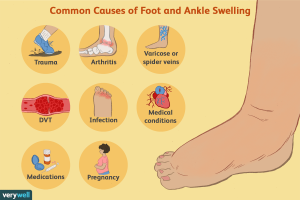health
Say Goodbye to Swollen Ankles: Understanding the Root Causes

Introduction
Swollen ankles can be a nuisance, causing discomfort and hindering mobility. Understanding the root causes behind this condition is crucial for effective management and prevention. In this comprehensive guide, we delve into the various factors that contribute to swollen ankles and provide insights into how to address them. Explore More About Health Problems And Their Solutions (Which Disease Usually Begins First)
What Causes Swollen Ankles?
1. Fluid Retention
Fluid retention, also known as edema, is one of the primary reasons behind swollen ankles. This occurs when excess fluid builds up in the tissues, leading to swelling and puffiness. Several factors can contribute to fluid retention, including:
- Sedentary Lifestyle: Lack of movement can impede proper circulation, causing fluids to accumulate in the lower extremities.
- High Sodium Intake: Consuming too much salt can disrupt the body’s fluid balance, leading to swelling in various areas, including the ankles.
- Medical Conditions: Certain medical conditions, such as heart failure, kidney disease, and liver problems, can impair fluid regulation, resulting in edema.
2. Injury or Trauma
Ankle injuries, such as sprains or fractures, can also cause swelling. When the ligaments or bones in the ankle are damaged, inflammation occurs as part of the body’s natural healing process. This inflammation can lead to swelling, pain, and restricted movement.
3. Poor Circulation
Healthy circulation is essential for maintaining fluid balance within the body. However, conditions that affect blood flow can contribute to swollen ankles. Common causes of poor circulation include:
- Peripheral Artery Disease (PAD): PAD occurs when the arteries that supply blood to the legs and feet become narrowed or blocked, leading to reduced circulation and swelling.
- Deep Vein Thrombosis (DVT): DVT is a blood clot that forms in a deep vein, typically in the legs. This can impede blood flow and cause swelling, pain, and other complications.
- Varicose Veins: Weak or damaged veins can struggle to efficiently return blood to the heart, resulting in fluid buildup and swelling in the ankles and lower legs.
4. Prolonged Standing or Sitting
Remaining in a stationary position for extended periods can hinder proper blood flow, contributing to swollen ankles. People who stand or sit for long durations, such as office workers or those in professions that require prolonged standing, may be more susceptible to this issue.
5. Obesity
Excess weight puts added pressure on the veins and lymphatic system, making it harder for fluids to circulate properly. As a result, individuals who are overweight or obese are more prone to experiencing swollen ankles.

Image by: yendex.com
How to Alleviate Swollen Ankles
1. Elevate the Feet
Raising the legs above heart level can help reduce swelling by facilitating the drainage of excess fluid from the ankles. Aim to elevate your feet for at least 15-20 minutes several times a day, especially after prolonged periods of sitting or standing.
2. Stay Active
Regular exercise is essential for promoting circulation and preventing fluid buildup. Engage in activities that encourage movement, such as walking, swimming, or cycling. Aim for at least 30 minutes of moderate exercise most days of the week.
3. Monitor Sodium Intake
Limiting your consumption of high-sodium foods can help prevent fluid retention and reduce swelling. Opt for fresh, whole foods and avoid processed items that are high in salt. Be mindful of condiments and sauces, which can also contribute to sodium intake.
4. Wear Compression Garments
Compression stockings or socks can help improve circulation and reduce swelling in the ankles and legs. These garments exert gentle pressure on the blood vessels, aiding in the movement of fluid and preventing pooling in the lower extremities.
5. Maintain a Healthy Weight
Striving for a healthy weight through a balanced diet and regular exercise can alleviate pressure on the veins and reduce the risk of swollen ankles. Aim to achieve and maintain a body mass index (BMI) within the recommended range for your height and build.

Image by: yendex.com
Swollen Ankles Prevention Strategies
| Prevention Strategies | Description |
|---|---|
| Elevate the Feet | Raise legs above heart level to facilitate fluid drainage and reduce swelling. |
| Stay Active | Engage in regular exercise to promote circulation and prevent fluid buildup. |
| Monitor Sodium Intake | Limit consumption of high-sodium foods to prevent fluid retention and swelling. |
| Wear Compression Garments | Utilize compression stockings or socks to improve circulation and reduce ankle swelling. |
| Maintain a Healthy Weight | Strive for a healthy weight through diet and exercise to alleviate pressure on veins and prevent swelling. |
Conclusion
Swollen ankles can stem from various underlying factors, including fluid retention, injury, poor circulation, prolonged sitting or standing, and obesity. By understanding the root causes of this condition and implementing preventive measures, individuals can effectively manage swelling and improve their overall quality of life. From lifestyle modifications to medical interventions, there are numerous strategies available to alleviate symptoms and promote ankle health.
Remember, if you experience persistent or severe swelling, consult a healthcare provider for proper diagnosis and treatment. Taking proactive steps to address swollen ankles can lead to increased comfort, mobility, and well-being.
health
Download Covid Vaccine Certificate by Aadhaar or Risk Travel Ban

Introduction
Even though most domestic restrictions around COVID-19 have eased in India, the vaccination certificate remains one of the most important health records in 2025. It continues to be essential for international travel, insurance documentation, and even in some workplaces where proof of vaccination is still required.
The government has made the process easier by allowing covid vaccine certificate download by Aadhaar number through official platforms such as CoWIN, DigiLocker, UMANG, and Aarogya Setu. Yet, many people are unaware of the new emphasis being placed on linking certificates with Aadhaar and how failure to do so could affect travel plans or claim settlements under a mediclaim policy.
What Is the New Rule and Why It Matters
While the rule’s details may vary by country or region, the core idea is that travelers should download or link their Covid vaccine certificate to their Aadhaar (a unique identity number used in India). Authorities may require this certificate as proof of vaccination when traveling, and not having it linked correctly could lead to complications or even a travel ban in some cases.
Here’s why the Aadhaar-linked certificate matters:
- It provides a reliable and verifiable identity proof tied to your vaccination record.
- It reduces the risk of fake or fraudulent vaccination certificates.
- It makes it easier for authorities (both in India and abroad) to check the authenticity of your vaccine status.
- It ensures smoother verification when registering on travel health portals or at immigration checks.
In short, the Aadhaar-based certificate is becoming a trusted way for governments and travel agencies to confirm your vaccination status safely and accurately.
Why the Covid vaccine certificate still matters in 2025
- International travel: Many countries require verified proof of vaccination before entry. Without a valid certificate linked to Aadhaar, passengers may be denied boarding.
- Insurance documentation: Health and mediclaim policies increasingly rely on digital health records. A vaccination certificate linked to Aadhaar ensures seamless claim approvals.
- Employment and education: Some organisations and foreign universities still require COVID-19 vaccination proof for compliance.
- Future vaccinations: Booster doses or new vaccines may need prior records for validation, making a digital certificate indispensable.
What information does the certificate carry?
When you complete your covid vaccine certificate download by Aadhaar number, the document contains:
- Name of the individual
- Age and gender
- Aadhaar number (partially masked)
- Reference or beneficiary ID
- Name of vaccine received
- Number of doses taken (including precautionary dose)
- Name of vaccination centre
- A secure QR code for verification
This ensures authenticity and prevents misuse.
Step-by-step guide to download using Aadhaar
1. Through the CoWIN portal
- Visit the official CoWIN website.
- Click on the ‘Download Your Vaccine Certificate’ option.
- Enter your registered mobile number linked with Aadhaar.
- Enter the OTP sent to your phone.
- Select the completed vaccination dose record.
- Click the ‘Certificate’ tab to download your digital copy.
2. Through the Aarogya Setu app
- Install and open the Aarogya Setu app.
- Log in with your mobile number and OTP.
- Navigate to the CoWIN section.
- Enter your beneficiary ID.
- Tap on ‘Get Certificate’ to download.
3. Through the UMANG app
- Download the UMANG app and log in using your mobile number.
- Go to the CoWIN services tab.
- Select ‘Download Vaccination Certificate’.
- Enter your Aadhaar-linked mobile number and OTP.
- Verify beneficiary details and download the certificate.
4. Through the DigiLocker app
- Install DigiLocker and register with your Aadhaar-linked mobile number.
- Search for ‘Covid Vaccine Certificate’ in the document section.
- Enter your beneficiary reference ID.
- Download and save your certificate for future use.
Link between vaccination certificate and mediclaim policy
Many people are unaware that vaccination status can directly affect a mediclaim policy. Here is how:
- Claim approvals: Some insurers may require vaccination proof for claims linked to COVID-19 or related complications.
- Cashless treatment: A certificate linked to Aadhaar makes digital verification faster at network hospitals.
- Premium stability: Maintaining verified health records, including vaccination, can influence underwriting decisions in long-term policies.
Failing to maintain an updated certificate could cause unnecessary delays in settlement or documentation.
The new push for Aadhaar-linked certificates
Government updates now encourage citizens to keep vaccination records linked with Aadhaar to ensure identity verification. This has several benefits:
- Authenticity: Prevents duplicate or fraudulent certificates.
- Convenience: Aadhaar-linked mobile numbers make OTP-based downloads simple.
- Universal use: One record can be used across government, travel, and insurance platforms.
In some cases, failure to show an Aadhaar-linked certificate for travel may result in a ban from boarding international flights.
Why Many Governments Favor Aadhaar‑Linked Certificates
Government and travel authorities often trust Aadhaar‑linked certificates for several reasons:
- Strong Identity Verification: Aadhaar is a widely accepted identification system in India. Linking it to vaccination records makes identity verification easier and more secure.
- Reduced Fraud: A certificate tied to Aadhaar is harder to forge, reducing fake vaccine certificates.
- Streamlined Verification: Immigration and health authorities can verify vaccination status more quickly when validated against a national ID system.
- Textbook Record Keeping: Linking to Aadhaar helps governments keep better digital records and ensures accurate updates for vaccine doses, booster shots, and renewals.
These reasons explain why an Aadhaar-connected certificate is becoming more popular for travel and health verification.
Important Things to Remember Before Traveling
- Always check the latest travel advisory for your destination country about Covid certificate rules.
- Make sure your certificate has your correct name, date of birth, and Aadhaar details.
- Keep a digital and a physical copy of your certificate.
- Verify that your QR code on the certificate scans correctly.
- Be ready to show your certificate along with your passport or national ID.
- Store your certificate safely in trusted apps like DigiLocker or UMANG.
Common mistakes to avoid
- Unlinked mobile numbers: Ensure your Aadhaar and mobile number are linked to receive OTPs.
- Lost reference ID: Save or note down your beneficiary ID to simplify downloads.
- Expired apps: Use updated versions of DigiLocker, UMANG, or Aarogya Setu for smooth access.
- Not saving copies: Keep both digital and printed versions to avoid last-minute issues.
Future relevance of the vaccine certificate
Even if COVID-19 risks appear lower today, the vaccination certificate will remain part of your official health records. Much like birth certificates or medical test reports, it may be required for:
- Enrolling in government health schemes.
- Renewing or upgrading insurance policies.
- Applying for visas or scholarships.
- Accessing institutional healthcare in India or abroad.
Conclusion
The importance of maintaining a verified COVID vaccine certificate has not diminished in 2025. With international travel and health insurance policies increasingly tied to vaccination records, the ability to complete a covid vaccine certificate download by Aadhaar number is essential.
For families, this document not only ensures smoother travel and medical access but also strengthens compliance with a mediclaim policy. By downloading and safely storing both digital and physical copies, individuals protect themselves from unexpected disruptions in healthcare or travel.
In the coming years, health documentation will only become more digital and Aadhaar-linked. Acting today to secure your COVID vaccine certificate is the simplest way to stay future-ready.
health
Senior In Home Care in Royal Oak, MI | Assured Home Nursing

Introduction
As people age, maintaining independence and comfort at home becomes increasingly important. Senior in-home care provides a solution that allows elderly individuals to live safely and comfortably in their own homes while receiving professional support. In Royal Oak, MI, Assured Home Nursing offers compassionate, personalized care that addresses both medical and daily living needs.
Many families face challenges when a loved one requires extra assistance. Balancing work, personal life, and caregiving can be stressful, and not all seniors are ready to move into a care facility. In-home care ensures that seniors get the support they need while staying in familiar surroundings.
Assured Home Nursing in Royal Oak, MI specializes in providing senior care that emphasizes dignity, independence, and quality of life. From companionship to medical support, their services are tailored to meet the unique needs of each individual. This article will explore the benefits, types of care, and why choosing Assured Home Nursing is an excellent decision for families and seniors.
What Is Senior In-Home Care?
Senior in-home care refers to services provided to older adults in the comfort of their own homes. Unlike nursing homes or assisted living facilities, in-home care allows seniors to maintain their routines while receiving assistance with daily tasks.
Services may include:
- Personal care such as bathing, grooming, and dressing
- Medication management and health monitoring
- Meal preparation and nutritional support
- Companionship and social engagement
- Light housekeeping and errands
- Transportation to medical appointments or social activities
The primary goal of in-home care is to enhance a senior’s independence while providing safety, support, and peace of mind to both the individual and their family.
Benefits of Senior In-Home Care
Choosing in-home care for seniors has many advantages, especially when provided by professional agencies like Assured Home Nursing. Some of the key benefits include:
1. Personalized Care
Every senior has unique needs. In-home care plans are tailored to match the specific health requirements, preferences, and lifestyle of each individual. Caregivers work closely with families to create a care plan that ensures comfort and safety.
2. Independence and Familiarity
Remaining at home allows seniors to enjoy a familiar environment, which is important for emotional well-being. In-home care helps them maintain independence while receiving the support they need.
3. Companionship
Loneliness can be a significant issue for older adults. Caregivers provide social interaction, engage in conversations, and participate in hobbies, helping to improve mental health and overall happiness.
4. Health Monitoring
Professional caregivers are trained to monitor vital signs, administer medications, and recognize early signs of health issues. This ensures prompt attention to medical needs and reduces the risk of complications.
5. Family Peace of Mind
Families often worry about the safety and well-being of their elderly loved ones. In-home care offers reassurance that their loved one is receiving attentive and professional care throughout the day.
Types of Senior In-Home Care Services
Assured Home Nursing provides a variety of in-home care services to meet different needs. These include:
1. Personal Care Assistance
Caregivers help seniors with daily tasks like bathing, dressing, toileting, and mobility. This support is essential for seniors who may have physical limitations or chronic conditions.
2. Skilled Nursing Care
Registered nurses can provide medical care, including wound care, medication management, IV therapy, and monitoring chronic illnesses. Skilled nursing is ideal for seniors who require professional medical attention at home.
3. Companionship Services
Caregivers offer friendly interaction, help with social activities, and provide emotional support to seniors who may feel isolated or lonely. Companionship services can significantly enhance quality of life.
4. Respite Care
Family caregivers often need breaks to rest or attend to personal matters. Respite care provides temporary relief by allowing trained caregivers to step in and ensure the senior’s needs are met during that time.
5. Specialized Care
Some seniors may have conditions like Alzheimer’s, dementia, or Parkinson’s disease. Specialized care programs address these conditions with trained caregivers who understand how to provide safe and effective support.
Why Choose Assured Home Nursing in Royal Oak, MI?
Assured Home Nursing stands out as a trusted provider of senior in-home care in Royal Oak, MI, for several reasons:
- Experienced and Compassionate Caregivers: All caregivers undergo thorough training to provide professional, empathetic care. They understand the emotional and physical challenges seniors face and provide support with patience and respect.
- Customized Care Plans: Assured Home Nursing creates personalized care plans tailored to each senior’s needs, preferences, and lifestyle. This ensures that every individual receives the right level of care and attention.
- Reliable and Flexible Services: Whether care is needed a few hours a day or around the clock, Assured Home Nursing offers flexible scheduling. Families can adjust services as needs change over time.
- Commitment to Safety: The agency prioritizes safety, from trained caregivers to adherence to health guidelines and best practices. This gives families confidence that their loved one is in good hands.
- Comprehensive Support: Assured Home Nursing provides a full spectrum of services, from personal care to skilled medical support, making it a one-stop solution for seniors and families in Royal Oak.
How to Get Started with Senior In-Home Care
Getting started with in-home care at Assured Home Nursing is simple:
- Initial Consultation: Families discuss the senior’s needs with a care coordinator.
- Care Plan Development: A customized plan is created to meet medical, personal, and emotional needs.
- Caregiver Assignment: Experienced caregivers are assigned based on the senior’s requirements and preferences.
- Ongoing Support: Regular updates and adjustments are made to ensure the senior receives optimal care.
This approach ensures a smooth transition into in-home care and builds trust between caregivers, seniors, and families.
Conclusion
Senior in-home care in Royal Oak, MI provides an ideal solution for families seeking professional support while allowing their loved ones to remain at home. Assured Home Nursing combines compassionate caregiving, medical expertise, and personalized care plans to ensure seniors live safely, comfortably, and with dignity.
From personal care to companionship, skilled nursing, and specialized support, in-home care meets a wide range of needs. By choosing Assured Home Nursing, families can gain peace of mind knowing their loved ones are in capable and caring hands. For seniors, it means enjoying independence, safety, and a higher quality of life in the comfort of their own home.
health
Abbott Cell Dyn Emerald 22 vs Emerald: Key Differences Explained

Introduction
Accurate and fast blood testing is very important in medical labs, and the choice of analyzer can greatly affect lab performance. Abbott is well known for its advanced diagnostic technology, and its Cell Dyn series is trusted for being reliable and precise. Two popular models in this series are the Abbott Cell Dyn Emerald 22 and the Cell Dyn Emerald. These are small, automatic hematology analyzers designed to fit different lab needs. While both provide high-quality and accurate results, they differ in their technology, features, and performance, making each one better suited for certain types of labs.
Knowing the differences between the Cell Dyn Emerald 22 and the Cell Dyn Emerald helps labs choose the right model based on their testing volume, workflow, and budget. Both machines give consistent results, but the newer version offers better efficiency and control during operation.
Overview of the Abbott Cell Dyn Emerald Series
You should know that the Abbott Cell Dyn Emerald series was developed to provide laboratories with dependable hematology analysis in a compact form. These analyzers are designed for small to medium-sized laboratories that need reliable complete blood count (CBC) results without the complexity or cost of larger systems.
It is important to understand that both the Abbott Cell Dyn Emerald 22 and the original Emerald model deliver high-quality results, but the 22 version incorporates advanced automation and updated software to improve workflow efficiency and analytical accuracy.
Core Similarities Between the Two Models
Both analyzers have many important features in common. They are built to handle regular blood tests, measuring things like red and white blood cells, platelets, hemoglobin, and hematocrit. Both models use impedance and optical technology to provide accurate cell counts and clear results.
You can count on either system to deliver fast and consistent results, helping doctors make better medical decisions. With easy-to-use software, a compact design, and automatic sampling, these analyzers allow labs to run reliable tests even when working with limited space or resources.
Key Differences in Design and Throughput
The Abbott Cell Dyn Emerald 22 is designed to work faster and perform better than the original Emerald model. While the standard Emerald can process about 60 samples per hour, the Emerald 22 can handle up to 80 samples per hour, helping labs manage a higher workload more efficiently.
The Emerald 22 also has an improved sampling system with both open and closed tube options, making it safer and more flexible to use. This feature is especially helpful for labs that focus on operator safety and want to reduce the risk of exposure to biohazards.
Workflow and User Interface Improvements
Efficient workflow is very important for keeping a laboratory productive, and the Abbott Cell Dyn Emerald 22 includes several features that make daily work easier. Its improved user interface is simple to use and gives quick access to test results, calibration settings, and maintenance tasks.
The updated software helps new users learn the system faster and shortens the time needed to complete tests. With its modern touchscreen and easy navigation menus, the Emerald 22 offers a more user-friendly experience—especially useful for labs that use several instruments.
Data Management and Connectivity
The Abbott Cell Dyn Emerald 22 also offers better data management with improved connectivity features. It can easily connect to laboratory information systems (LIS), allowing quick and accurate transfer of test results.
While the original Emerald has basic data storage and transfer options, the Emerald 22 includes more memory, easier data access, and stronger security for managing results. This makes it a great choice for labs that focus on traceability and meeting quality and compliance standards.
Reagent Efficiency and Cost-Effectiveness
Both analyzers are designed to use reagents efficiently, helping reduce waste and operating costs. However, the Abbott Cell Dyn Emerald 22 takes this a step further with improved fluidics and reagent monitoring systems that make reagent use even more efficient.
These upgrades not only save on reagent costs but also increase instrument uptime by reducing how often maintenance is needed. For labs that want to maintain accuracy while keeping costs low, this is a major benefit.
Quality Control and Calibration Systems
You should know that both analyzers incorporate advanced quality control features to ensure accurate and reliable results. However, the Abbott Cell Dyn Emerald 22 integrates automated quality checks that operate continuously during testing, providing an additional layer of confidence.
It is important to understand that this automation reduces the potential for manual errors and ensures consistent calibration, allowing laboratories to maintain compliance with international quality standards. Learn more by visiting this link.
Choosing Between the Two Analyzers
You should know that the choice between the Abbott Cell Dyn Emerald 22 and the Cell Dyn Emerald depends on your laboratory’s needs. The Emerald remains a dependable solution for smaller laboratories that require accurate hematology testing without advanced automation.
It is important to understand that the Emerald 22 offers improved performance, safety, and efficiency, making it better suited for laboratories with growing workloads and a focus on data management.
Conclusion
You should know that both the Abbott Cell Dyn Emerald and the Abbott Cell Dyn Emerald 22 are reliable hematology analyzers built on Abbott’s proven diagnostic technology. However, the 22 version introduces significant advancements in automation, throughput, and user interface design.
It is important to understand that laboratories seeking higher productivity, enhanced safety, and seamless connectivity will find the Abbott Cell Dyn Emerald 22 a valuable upgrade. Meanwhile, smaller facilities that prioritize affordability and simplicity can continue to rely on the original Emerald for consistent, high-quality results.
You can confidently conclude that while both analyzers deliver accurate hematology performance, the Abbott Cell Dyn Emerald 22 represents a new generation of efficiency, precision, and innovation in modern laboratory testing.
-
Business2 years ago
Cybersecurity Consulting Company SequelNet Provides Critical IT Support Services to Medical Billing Firm, Medical Optimum
-
Business2 years ago
Team Communication Software Transforms Operations at Finance Innovate
-
Business2 years ago
Project Management Tool Transforms Long Island Business
-
Business2 years ago
How Alleviate Poverty Utilized IPPBX’s All-in-One Solution to Transform Lives in New York City
-
health2 years ago
Breast Cancer: The Imperative Role of Mammograms in Screening and Early Detection
-
Sports2 years ago
Unstoppable Collaboration: D.C.’s Citi Open and Silicon Valley Classic Unite to Propel Women’s Tennis to New Heights
-
Art /Entertainment3 years ago
Embracing Renewal: Sizdabedar Celebrations Unite Iranians in New York’s Eisenhower Park
-
Finance3 years ago
The Benefits of Starting a Side Hustle for Financial Freedom































